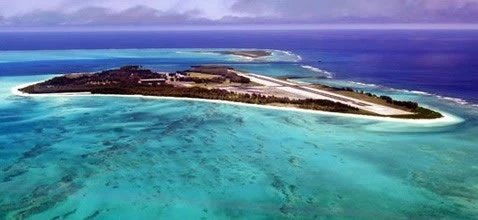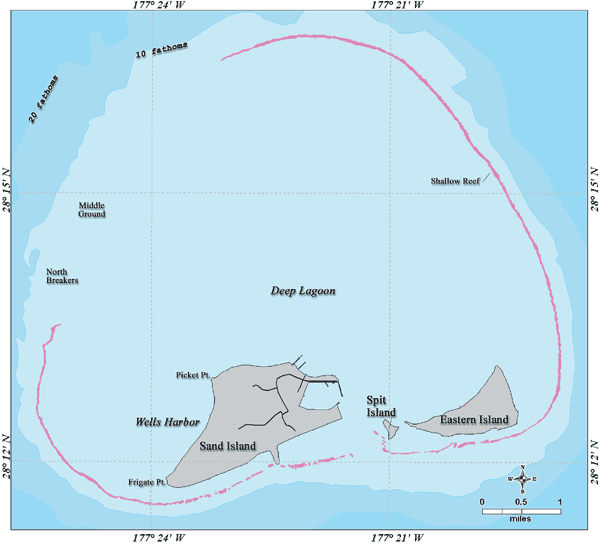Midway Atoll
Midway Atoll is a remote, ecologically rich atoll at the far northwestern end of the Hawaiian archipelago. Known for its pivotal role in World War II, Midway is also home to the world's largest colony of Laysan albatrosses and vibrant marine life. Though not part of the state of Hawaii, the atoll is protected and managed by the U.S. Fish and Wildlife Service and serves as both a historic landmark and a biodiversity hotspot.

As its name implies, Midway Atoll lies about half way between North America and Asia, like a stepping stone mid-way. Midway Atoll is also known as Midway Island or Pihemanu in the Hawaiian language. Encompassing 2.4 square miles (6.2 km²), the circular-shaped atoll consists of a ring-shaped barrier reef and a few sand islets. The three main ones are Sand Island, Eastern Island and Spit Island, located on the southern end of a lagoon and home to almost two million birds.
Midway is probably the best known island in the Northwestern Hawaiian Island chain. While it is part of the Hawaiian archipelago, Midway is legally not part of the state of Hawaii. The Midway Islands are administered by the U.S. Fish and Wildlife Service. The atoll has a small population of researchers and administrators (less than 100) and there is a visitor's program, which allows small groups of visitors to learn about and experience Midway's unique ecosystems.
In 1859, Captain Brooks sailed to Midway Atoll and after that, the U.S. annexed it. The atoll was the country's first insular possession outside the continental U.S. In 1870, the U.S. recognized the strategic importance of Midway and began clearing a southern channel into the lagoon to create a port on Sand Island. Midway was later (in 1903) an important link in cable communications and a transpacific Panamerican seaplane stop (in 1935). In 1940, the work to build a military facility on the atoll began.
Midway Atoll became even more popular after the Battle of Midway, fought in World War II, from June 4 to 6 in 1942, when a small U.S. task force surprised and defeated the Japanese invasion fleet that was bound for the atoll. Midway Atoll was designated as the National Memorial to the Battle of Midway in 2000.
Over the years, Midway Atoll has been altered extensively by humans. The atoll has 20 miles (32 km) of roads, 4.8 miles (7.8 km) of pipelines, a port on Sand Island and a runway, about 8,000 feet (2400 m) long.
Almost two million birds of 19 species nest on Midway Atoll. Species include Laysan albatrosses (the atoll is home to the largest Laysan albatross colony in the world), black-footed albatrosses, white terns, red-tailed tropicbirds, shearwaters, black and brown noddies and Bonin petrels.
Seventy-five percent of Midway's plant species were introductions, including exotic vegetables, weeds, ornamental shrubs, coconut palms and ironwood. The marine life is abundant. More than 250 fish species can be found here, including hapuupuu (the Hawaiian grouper), kumu (goatfish), ulua (jack) and sharks. There are also many dolphins, turtles and monk seals. Moreover, 16 stony coral species have been reported.

Frequently Asked Questions
Where is Midway Atoll located?
Midway Atoll lies approximately halfway between North America and Asia in the Pacific Ocean. It is part of the Northwestern Hawaiian Islands but is not legally part of the state of Hawaii.
What wildlife is found on Midway Atoll?
Midway hosts nearly two million birds, including the world’s largest colony of Laysan albatrosses. It is also home to monk seals, green sea turtles, dolphins, and over 250 species of fish.
What is the historical importance of Midway Atoll?
Midway was the site of the pivotal Battle of Midway in World War II, where U.S. forces defeated the Japanese navy. In 2000, it was designated a National Memorial to commemorate the battle.
Is Midway Atoll open to the public?
Access to Midway is limited and managed by the U.S. Fish and Wildlife Service. A small visitor program exists, but permits are required due to the island’s sensitive wildlife and protected status.
Is Midway part of the Papahanaumokuakea Marine National Monument?
Yes. Midway Atoll is included in the Papahanaumokuakea Marine National Monument, a vast marine reserve that protects wildlife, cultural heritage, and important ecosystems in the Northwestern Hawaiian Islands.








